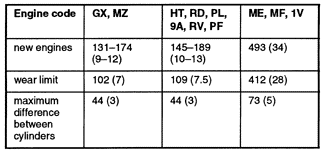Compression Test
A test of compression pressures in the individual cylinders will tell a lot about the condition of the engine without the need for taking it apart. For gasoline engines, the test is relatively simple. It requires a compression tester, a spark plug wrench, a screwdriver, and a jumper wire to disable the ignition system. Diesel and turbo diesel engines with their higher compression pressures require a more expensive tester. For diesels and turbo diesels, it may be more economical to have a compression test performed by a Volkswagen dealer or other qualified shop.
For a compression test of either type of engine, the battery and starter must be capable of turning the engine at normal cranking speed to achieve meaningful results. The area around the spark plugs or injectors should be clean, to avoid getting debris inside the engine when they are removed. Because engine temperature may affect compression, the most accurate results are obtained when the engine is at normal operating temperature.
To test compression (gasoline engine):
| 1. | With the ignition off, disable the secondary circuit of the ignition system. On all except engines with CIS-E Motronic or Digifant I fuel injection, disconnect the coil wire from the center tower of the distributor cap and connect it to ground on the engine block using a jumper wire. On engines with CIS-E Motronic or Digifant I fuel injection, disconnect the harness connector for the coil power stage. |
| 2. | Disconnect one end of the duct between the air flow sensor and the throttle body to disable the fuel injection system. |
| 3. | Remove the spark plug wires from the spark plugs. Use care to pull on both the wire and the boot at the same time to avoid damage to the connectors. Label the wires so that they can be reattached to the correct spark plugs. |
| 4. | Remove the spark plugs and set them aside, in order corresponding to the cylinders from which they were removed. |
| 5. | Thread the compression tester into the first cylinder's spark plug hole, just tight enough to seal around the spark plug hole. Use care not to damage the seal on the gauge line. |
| 6. | With the transmission in neutral and the throttle held wide open, crank the engine with the starter. The gauge reading should increase with each engine revolution. Continue cranking until the gauge reading stops increasing (about 4 to 5 revolutions). Record the highest value indicated by the gauge. |
| 7. | Release the pressure, either with the gauge valve or by slowly removing the gauge, allowing the pressure to bleed off while threading it out of the spark plug hole. |
| 8. | Repeat the test for each of the other cylinders. Record the data and compare with Table c. |
| 9. | Reinstall the spark plugs and the spark plug wires in their original locations. Reinstall the air duct. Reconnect the coil wire or harness connector. |
To test compression (diesel engine):
| 1. | Disconnect the wire from the fuel shutoff solenoid on the injector pump. |
| 2. | Unscrew the fuel pipe union nuts from the injection pump and the fuel injectors. Remove the fuel pipes as a unit, taking care not to bend them. |
WARNING-
Fuel will be expelled as you loosen the unions. Do not smoke or work near heaters or other fire hazards. Have a fire extinguisher handy.
|
| 3. | Using a 27 mm deep socket, remove the injectors, and then remove the heat shields from each injector hole. |
WARNING-
If the heat shields are not removed along with the injectors, compression pressure will expel them with dangerous force when the engine is turned over.
|
| 4. | Thread the compression tester, with an injector heat shield, into the first cylinder's injector hole. Thread the gauge in tight enough to seal. |
| 5. | With the transmission in neutral, crank the engine with the starter. The gauge reading should increase with each engine revolution. Continue until the gauge reading stops increasing (about 4 to 5 revolutions). Record the highest value indicated by the gauge. |
| 6. | Release the pressure, either with the gauge valve or by slowly removing the gauge, allowing the pressure to bleed off while threading it out of the injector hole. |
| 7. | Repeat the test for each of the other cylinders. Record the data and compare with Table c. |
| 8. | Reinstall the injectors with new heat shields. Torque the injectors to 70 Nm (51 ft. lb.). For correct heat shield installation position, see FUEL SYSTEM-DIESEL. |
| 9. | Reconnect the fuel lines and torque the fittings to 25 Nm (18 ft. lb.). Reconnect the wire to the fuel shutoff solenoid. |
Table c. Compression Pressure Specifications in psi (bar)

Low compression is evidence of poorly sealed combustion chambers. The characteristics of the test results help isolate the cause or causes. Generally, compression pressures which are relatively even but below acceptable specifications indicate worn piston rings and/or cylinder walls. Low but erratic values tend to indicate valve leakage. Dramatic differences, such as acceptable values in some cylinders and very low values in one or two cylinders are the sign of a localized failure, probably of a head gasket. There are two more tests which can further isolate the problem.
|
